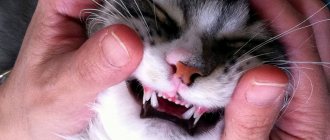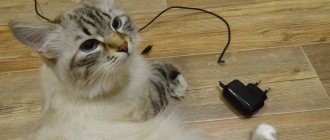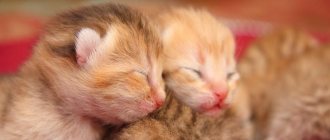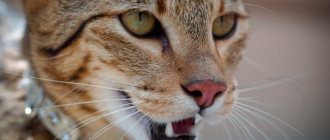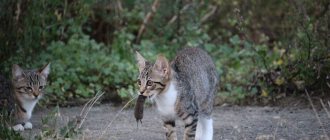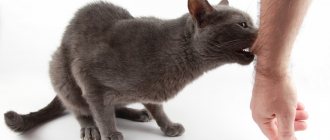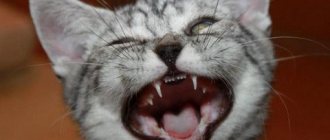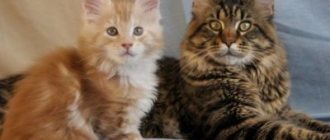Teeth for representatives of the cat family are a tool for obtaining food, protection, hunting, carrying kittens, and caring for their fur. Like humans, cats change teeth once in a lifetime, when the milk teeth fall out and in their place permanent teeth grow, with which the pet will have to live its entire adult life. The further healthy and comfortable existence of the animal depends on how the replacement process goes.
Formation of primary dental occlusion
Almost all mammals are born toothless. Cats are no exception: the oral apparatus of a newborn kitten is maximally adapted for effective sucking. After all, the only food available to him is mother’s milk.
At two weeks of age, kittens develop milk teeth - straight, small, sharp, milky white. In adult cats they are powerful and curved. They are called milk teeth because they appear in kittens during breastfeeding.
Interesting! The front milk teeth of kittens are straight, and the fangs are curved.
Teething order
The eruption period lasts up to two months. By this age, the cat already has 26 baby teeth. They do not appear all at once, but in a certain order:
- 2–4 weeks. Incisors appear. First, 2 in the center of the jaw, then 4 more are added to them on both sides. There are 12 incisors in total - 6 each on top and bottom.
- 3–4 weeks. Fangs appear: 4 upper and 4 lower. They are located on the sides of the incisors.
- 4–8 weeks. The appearance of pre-masticating teeth - premolars: 4 on the lower jaw and 6 on the upper jaw.
Important! Milk teeth will serve kittens up to the age of 3-4 months with proper care and timely introduction of complementary foods.
Changing baby teeth to permanent ones
The replacement of baby teeth with permanent teeth in cats begins at 4 months. The formation of the masticatory apparatus is completed at 7–8 months. The time it takes for a permanent bite to develop may vary among different cat breeds. A slight advance or delay in deadlines is allowed.
Shift order
The location and order of changing baby teeth to permanent ones is clearly depicted in the figure below. The first to fall out are the deciduous incisors. Fangs change after complete replacement of incisors. Next comes the replacement of the premolars. After a complete change, 4 molars erupt - the main chewing ones. In the picture they are colored blue.
Types of permanent teeth
An adult cat should have a total of 30 teeth. For a cat, it is a weapon, a means of protection, defense and attack. Mother cats use their front incisors to gently grab and carry the kitten.
Interesting! In cats, the lower jaw can only move in a vertical plane, so it is incorrect to say that cats chew their food. They crush it, crush it into small pieces.
The table describes the location of cat teeth, their number and functional load.
| Upper jaw | Incisors – 6 | They serve to hold prey and tear off small pieces of food. | Fangs – 2 | Used for self-defense, capturing and chopping food | Premolars – 6 Molars – 2 | They grind the bones and crush large pieces. |
| Lower jaw | Incisors – 6 | Fangs – 2 | Premolars – 4 Molars – 2 |
Molars are located deep in the jaw. Their presence indicates that the cat has become an adult. During this period, he begins to mark his territory.
Cat jaw structure
Typically, the jaws of cats are well developed and have a peculiarity: the movement of the lower jaw occurs only vertically. The animal bites the food, as if cutting it.
Each tooth has enamel, dentin, pulp and root (1-3), as well as its own role. Let's open the cat's mouth and see that in front there are 12 incisors for holding prey in the mouth.
Next are long fangs, firmly seated in the bone: two below, two above. Their function is to grind food, and they also help in hunting and self-defense.
Behind the canines, premolars and molars are visible, which allow them to chew food and grind bones.
Symptoms of teething or changing teeth
By the behavior of kittens and the reaction of a nursing cat, you can understand that they are cutting their first teeth. The appearance of primary incisors is accompanied by swelling and soreness of the gums. The kitten is trying to get rid of unpleasant sensations, so during feeding it clenches its jaws with force and bites its mother's nipple.
Sharp incisors can injure the nurse. But this period does not last long and often goes unnoticed by the owners.
By the end of the 4th month, the rudiment of a permanent tooth is formed in the gums of the upper and lower jaws under each milk tooth. As it grows, baby teeth shift, are pushed out of the gums and fall out one by one. This occurs at approximately 5 months.
Replacing baby teeth with permanent ones causes noticeable changes in the kitten's behavior. During this time, your pet's condition should be monitored to help if complications arise.
Symptoms of teeth changing in kittens:
- When young cats lose their baby teeth, they become biters in an attempt to get rid of itchy gums. You should not allow the kitten to bite the owner's hands. It will be very difficult to re-educate him later.
- Excessive salivation appears - ptyalism. This is how nature protects delicate gums from possible inflammation.
- An unpleasant odor appears from the mouth. The reason is moderate inflammation.
- Possible increased body temperature, lethargy or agitation, aggression. This is a reason to contact a veterinarian.
- Kittens lose their appetite or refuse solid food because their swollen, inflamed gums are painful to chew. Dry food should be removed from the diet, leaving only soft food.
Important! When kittens change teeth, it is necessary to exclude the animal from access to anything that could harm it. For example, when chewing wooden surfaces, a cat can hurt its gums.
To make the teething process go smoothly, you can purchase special “chewing” toys.
Lost primary incisors can be discovered by the owner during play. But most often kittens swallow them while eating. This is normal - everything will work out naturally.
Possible complications
The eruption of baby teeth and their replacement with permanent teeth are natural processes of growth for any animal. They must take place on time. It is necessary to contact a veterinarian in time if complications arise:
- The kitten has been sleeping poorly for the last 24 hours, not eating, restless, and meowing.
- The unpleasant odor does not go away for a long time, it becomes pungent - periodontal disease may develop.
- Excessive secretion of saliva and its thickening - the likelihood of gingivitis or stomatitis.
In order not to miss alarming symptoms when cats change teeth, you need to regularly examine the oral cavity.
Gum inflammation
A healthy cat's gums should be pale pink and free of swelling. During eruption, swelling, redness, slight swelling and short-term bleeding are allowed. These phenomena quickly pass: the swelling quickly subsides, the hole in the place of the lost tooth heals without a trace.
You should not postpone a visit to the veterinarian if:
- inflammation has occurred around the baby tooth;
- Reddened gums bleed for a long time;
- pus appears on the gums or in the sockets;
- the baby incisor is “slanted” and injures the gums, this usually happens with fangs.
All of these signs are symptoms of periodontal disease, stomatitis, and gingivitis. Purulent inflammations are especially dangerous.
Interesting! Scottish Fold cats are the most prone to gum disease. The owners of Scottish dogs should be especially attentive to them during this difficult period.
Residual baby teeth
Usually the new tooth grows in its own socket. Therefore, it often happens that a permanent one grows next to a milky one that has not yet fallen out. This is the norm, but if a baby tooth does not fall out in 8 months, this is a reason to consult a doctor.
An anomaly, when permanent teeth have already erupted, but milk teeth have not yet fallen out, is rare. In this case, a double dentition is formed and, as a result, an incorrect bite. In this case, the oral mucosa, the inside of the cheeks, and the kitten’s tongue are injured.
If more than one or two primary incisors remain in the pet's jaw, surgical intervention and strict monitoring of the subsequent eruption process are inevitable.
Expert opinion
Chepa Natalya Semenovna
Veterinarian
Ask an expert
In some cases, kittens may develop juvenile gingivostomatitis after teething. This is an inflammation of the gums that develops after the appearance of permanent teeth. Young cats under 2 years of age are affected. The exact causes of the inflammatory process have not been fully established. The disease probably occurs against the background of an allergic reaction of the body to plaque bacteria. Some breeds have a predisposition: Maine Coons, Sphynxes, Bengals, Orientals. Characteristic signs of juvenile gingivostomatitis are bad breath, redness and swelling of the gums. To treat the disease, sanitation of the oral cavity with antiseptics, for example, Miraxidin solution, is prescribed. In difficult cases, ultrasonic teeth cleaning may be required. To prevent the disease, it is recommended to brush your pet’s teeth with special pastes for animals. Moreover, it is better to accustom your cat to the procedure from childhood.
Causes of tooth loss in adult pets
Cats suffering from such dysbiosis in the oral cavity are potential candidates for rapid tooth loss.
The main reasons for the development of dysbiosis are previous viral diseases or the penetration of infection into the body. If cats have a serious gastrointestinal disease, the condition of the oral cavity can also rapidly deteriorate. Dysbacteriosis also appears due to prolonged use of drugs, antibiotics or hormonal therapy. Sometimes, the answer to the question “why do adult cats start losing teeth?” is a metabolic disorder and the occurrence of immunodeficiency.
One factor will be quite enough for irreversible consequences to begin in the animal’s body. Bacteria are multiplying, basically, at an unprecedented rate. And even in the presence of a pathological process, they contribute to its rapid development.
Oral care
To maintain healthy teeth for your pets, you need to follow three basic rules:
- From an early age, it is necessary to provide the kitten with a healthy, balanced diet, sufficient amounts of minerals and vitamins. The veterinarian will help you choose food in accordance with the age and physiological characteristics of the cat. Cleaning of the incisors occurs naturally: when the animal chews solid food. That’s why the presence of dry food and large pieces in a cat’s diet is so important. Mechanical action on the surface of the teeth cleanses them of plaque and protects them from the formation of tartar.
- Compliance with the rules of basic oral hygiene. The list of kitten care procedures should include mandatory cleaning. Baby teeth can be cleaned with a soft cloth. The kitten will enjoy this procedure if a special paste for cats is applied to the fabric - it has a pleasant smell and taste. Changing incisors can be cleaned with a brush: the kitten will happily chew on the soft bristles, which will help cope with the itching. As your permanent teeth grow in, you can move on to brushing with a stiffer bristled brush. The procedure is carried out with light movements from roots to ends. Regularity – 2–3 times a week.
- Constant availability of sufficient clean water.
If tartar or other pathologies appear, you should contact your veterinarian. The treatment takes place under anesthesia, so there is no need to worry about the moral and emotional state of your pet.
Self-examinations conducted by the owner and regular visits to the veterinarian will help raise a strong, beautiful pet and maintain the health of its teeth for a long time. Regularity is important - this will allow you to identify problems in time and help the animal.
How to prevent the disease from appearing?
But don’t despair – you can always help your cat. Firstly, it should be understood that diseases of the oral cavity leading to tooth loss, like other ailments, are much easier to prevent than to take a long and expensive time to treat. After consultation with a doctor, wiping the cat’s teeth and gums with 0.05% chlorhexidine is often used to prevent the disease. You can purchase the product at a pharmacy without a prescription.
In addition, the procedure for brushing the animal’s teeth should be as mandatory as for the owner himself. In veterinary pharmacies, special brushes and toothpastes for cats are in great demand, with the help of which the procedure is easy for humans and comfortable for a furry pet.
The appearance of at least one of the above symptoms of oral disease without proper attention can lead to the animal losing its teeth. Take the health of our little brothers seriously, because we are always responsible for them.
We recommend reading: Treatment and prevention of tartar in cats
